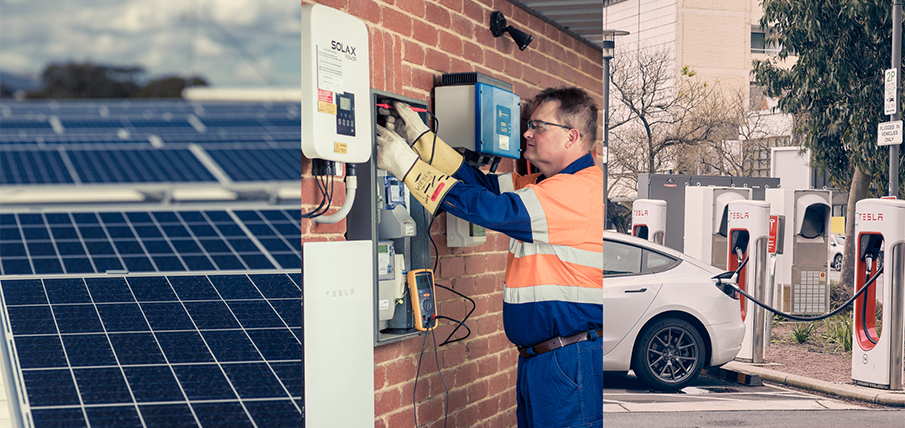Demand Flexibility: The Key to Australia's Energy Future

Australia's energy transition is gathering pace-and communities are at its heart.
Opinion piece by
|
As more households electrify their homes, install rooftop solar and batteries, and invest in electric vehicles, the transformation of our energy system is no longer happening in power stations or policy papers. It’s happening on our rooftops, in our driveways, and inside our living rooms.
For SA Power Networks, this presents both an extraordinary opportunity and a fundamental challenge. Demand on our electricity network is forecast to double by 2050, driven by the electrification of homes, businesses and transport. That means more people using more electricity, and it requires a critical reshape of how and when they use it, so we can avoid billions of dollars of unnecessary network build-out.
If we get this right, we can build a future where households and businesses are not just passive consumers of electricity, but active players in a dynamic, low-emissions energy system. But that depends on unlocking what we see as the “holy grail” of the energy transition: demand flexibility.
What is demand flexibility—and why does it matter?
Put simply, demand flexibility means rewarding homes and businesses for shifting their energy use to different times of day, especially when renewable energy is abundant, or the network has spare capacity. It’s a smarter way to use electricity that leads to a more efficient, affordable and reliable energy system for everyone.
And this is the critical point: even if you're not directly participating in flexible energy programs, you still benefit. When enough people shift their usage—say, running appliances or charging their electric vehicles during the day instead of the evening—it reduces peak and minimum demand, avoids costly upgrades to the electricity network, and puts downward pressure on energy prices for all customers.
The value stack: Shared benefits across the system
When we talk about demand flexibility, we’re talking about unlocking a “value stack”:
- Household value – Direct savings or earnings by optimising when and how you use energy.
- Network value – Reduced need for expensive upgrades to poles and wires, helping keep everyone’s electricity bills lower.
- Market value – Reduced reliance on expensive fossil-fuel generation by shifting demand to times when renewable energy is plentiful.
Our role at SA Power Networks is to help make that value stack real, tangible, and accessible—so it delivers meaningful outcomes for everyday customers and benefits the whole system.
Picture: Illustrative savings from electrification and demand flexibility.
Making it real: what demand flexibility can look like
Imagine you’ve signed up through your energy provider to make your home a little more flexible. You’ve got ‘smart’ appliances, and you’ve opted in to allow your electric vehicle charger, battery, or air conditioner to adjust automatically at certain times, based on preferences you’ve set in your app.
Once you’ve made that choice, it’s set and forget. You don’t need to manage it day to day. Behind the scenes, your provider shifts energy use to times when renewable energy is plentiful or the network is under less pressure—like delaying EV charging until later in the evening or slightly adjusting your air conditioner’s temperature by a couple of degrees.
In return, you get a monthly reward—a credit on your bill, a rebate, or a financial incentive for your participation.
And you're still in control. You can update your settings at any time, scale your participation up or down, or even choose to opt out of specific events if needed. But if you opt out during a flexibility event, you may miss out on some of your reward for that period.
It’s not about micromanaging your energy use—it’s about enabling your home to work smarter in the background, based on what you’re comfortable with. Small, automated actions based on your preferences can add up to big system benefits: reducing peak demand, lowering emissions, and helping keep costs down—for you and for everyone on the grid.
What needs to change?
While the momentum is building, there are still barriers to scale. For demand flexibility to become part of everyday life:
- Technology must be ‘interoperable’ and affordable.
- The customer journey—from discovery to installation to daily use—must be seamless.
- And perhaps most importantly, financial incentives must be strong enough to drive lasting behaviour change.
The good news is we’re seeing the beginnings of this shift. Programs like Energy Masters show what’s possible when households are equipped with the right tools and support. The challenge now is scale: how do we move from successful pilots to mainstream adoption?
Networks as system orchestrators
At SA Power Networks, we believe electricity networks have a critical role to play. We’re no longer just asset managers—we can help orchestrate the entire electricity system to operate in a way that maximises value and maintains reliability.
That means integrating customer energy resources—solar panels, batteries, electric vehicles, and smart appliances—into the grid efficiently and to deliver maximum value. It also means making participation in that system easy and rewarding for all customers, not just the early adopters.
A shared opportunity
The future grid will be customer-shaped and community-powered. But only if we work together—industry, government, households and businesses —to make demand flexibility not just a technical feature, but a practical, everyday reality.
When we activate demand flexibility at scale, we unlock lower costs, greater resilience, and cleaner energy—for everyone.
James Brown, SA Power Networks’ Senior Manager of Enterprise Innovation and Board Member of the Energy Efficiency Council, will be joining a panel discussion on “From Pilot to Powerhouse” at the Energy Efficiency Council Annual Conference on May 27.
More
James Brown, SA Power Networks’ Senior Manager of Enterprise Innovation and Board Member of the Energy Efficiency Council, will be joining a panel discussion on “From Pilot to Powerhouse” at the Energy Efficiency Council Annual Conference on May 27.